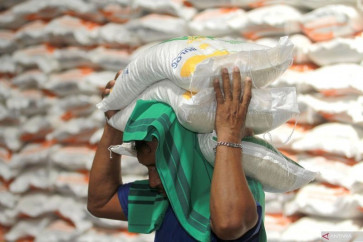Popular Reads
Top Results
Can't find what you're looking for?
View all search resultsPopular Reads
Top Results
Can't find what you're looking for?
View all search resultsLiving up to the passion for tulips
Burst of spring colors
Change text size
Gift Premium Articles
to Anyone
Burst of spring colors.
The tulips of my childhood in Central Java were the ones I saw in a comic telling the story of a grandma who woke up at dawn to see tulips bloom in her garden.
That story inspired me to check out any buds in my garden that opened early in the morning and smell the fragrance they emitted.
Exposure to another story about a black tulip and the postcard of colorful tulips in bloom with lakes and trees in Keukenhof, the world's most famous tulip garden, made me want to see the tulips in person, not only in pictures or stories.
I was not aware of any tulips that grow in Indonesia until I was invited to a villa in the Coolibah residential complex in Puncak, West Java, where I saw some tulip bulbs protruding from soil with sun-scorched leaves and no petals.
That was my first physical encounter with the tulip. The owner of the villa told me he bought the tulip bulbs from the Netherlands.
'Apparently they won't grow here,' he said, disappointingly. Some years later I was reminded of tulips by the daffodils I saw in a mountain bungalow in Central Java. Well, if daffodils are successfully grown down here, so too would tulips.
Some people here may have successfully grown tulips in their high-altitude gardens for their own private viewing and enjoyment.
Since then, I occasionally come across some single early tulips of one light color as cut flowers at some high-end parties, dinners and flower shops in Jakarta.
However, this variety, perhaps the cheapest and most widely available, does not make an impressive presence when mixed with more showy flowers in Western-style flower arrangements.
Recently, however, my interest in those wineglass-shaped flowers was rekindled when I was informed on the recent 'tulip mania' exhibition in Singapore's Garden by the Bay, a 101-hectare park of reclaimed land.
So, I went there and found hundreds of visitors queued to buy tickets S$16/person (US$12.67) to enter the Garden's 1.2 hectare Flower Dome whose temperature had been made slightly cooler than usual to accommodate the tulips.
There was an engaging Little Keukenhof inside, decorated with Dutch clogs and a windmill replica. Had my aunt been alive today, she would have said that this mini, artificial Keukenhof was no match for the real one.
The tulips on display were mostly the single or young ones, plus some parrot and peony varieties. They came with their usual companions, the hyacinth and the daffodil.
I did not see any unusually colored tulips such as the blue tulip or the black tulip. Although the air was scented, none of the tulips I smelled emitted fragrance.
There was a bed of withered, ugly-looking orange-turned-ochre parrot tulips that the gardener forgot to uproot ' a reminder of the seasonality and temporariness of youth and beauty, and how the ravages of time cruelly deprive them of both their attractiveness and existence as obvious in the empty row I found some distance away from that bed, whose inhabitants have expired earlier than their neighbors.
In spite of these, however, the exhibition delighted me greatly. Finally I found myself in a real tulip garden, not in the printed or imagined one as in my childhood.
I saw beauty all around me and felt an American Indian prayer physically realized. Here, tulip mania was at work in sensory terms instead of financial terms with which it is usually associated.
Passion for the flower ran high. People had to queue to get photographed with tulips or take pictures of them. A man had a young boy hold a black cloth as background for a pot of white tulips he wanted to photograph.
Thanks to the exhibition, I did not have to spend long hours traveling to Amsterdam to see tulips. After all, Singapore is just one hour 20 minutes away from Jakarta by plane.
This exhibition also enabled the elderly who were not fit to travel too far to enjoy the bloom in a controlled environment without being subjected to the whims of the weather and study the world's third most popular flower after the rose and the chrysanthemum and many other plants from across the globe.
But the most interesting thing I learned about the tulip is the edibility of their petals and the toxicity of their bulbs.
'The pink, peach and white petals are said to be the sweetest, the red and yellow ones are the most flavorful,' read a garden sign.
So, I took some white, yellow, red and purple petals and tasted them. They have nutty, lettuce-like taste with a dash of sweetness. The purple ones were spicy, and the red especially flavorful. They are the most delicious flower I have ever tasted raw, tastier than nasturtium. What's more, they make me feel the joy of springtime thriving inside me.
' Photos by Arif Suryobuwono










